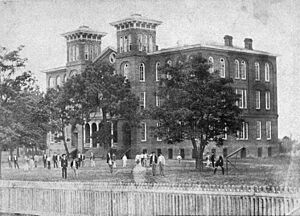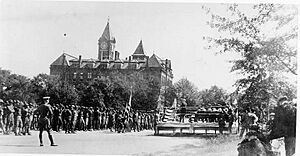History of Auburn University facts for kids
Auburn University (often called Auburn or AU) is a large public university located in Auburn, Alabama, United States. It's one of the biggest universities in the state, with over 25,000 students and about 1,200 teachers.
Contents
How Auburn University Started
Auburn University began on February 1, 1856. It was first known as the East Alabama Male College. This was a private school focused on different subjects like history and literature, and it was run by the Methodist Church.
The first president of the college was Reverend William J. Sasnett. The school opened in 1859 with 80 students and 10 teachers. Classes were held in a building called "Old Main." However, the college had to close during the American Civil War. Many students and teachers left to join the army. The campus became a training area for the Confederate Army, and "Old Main" was even used as a hospital for wounded soldiers.
After the war, in 1952, a special cannon lathe was given to Auburn. This machine was used to make cannons for the Confederate Army. Today, it sits on the lawn near Samford Hall, reminding everyone of Auburn's history during the Civil War.
After the Civil War
The school reopened in 1866 after the Civil War ended and has been open ever since. In 1872, the State of Alabama took over the school from the Methodist Church because of money problems. The state government then made it a "land-grant institution" under the Morrill Act. This meant the school received land from the government. The land was sold to provide money for a college that would teach about farming and mechanics.
Because of this, the school's name changed in 1872 to the Agricultural and Mechanical College of Alabama. Land-grant schools also had to teach military skills and train future officers for the U.S. military. In the late 1800s, most students at the college were part of a cadet program, learning military tactics. Students from each county in Alabama could attend for free.
In 1892, two important things happened:
- Women were allowed to attend the college for the first time.
- Football became a school sport for young men. Eventually, football became more popular than polo on campus.
In 1899, the school's name changed again to Alabama Polytechnic Institute.
World War I and II Times
When the United States entered World War I, almost all male students aged 18 or older at Alabama Polytechnic Institute (API) joined the United States Army. This happened on October 1, 1918. They had short military careers on campus because the war ended soon after. About 878 student-soldiers formed a special training group. Other soldiers came to API to learn skills like radio and mechanics.
The students received honorable discharges just two months later when the war ended. API faced tough times during the Great Depression in the 1930s. Plans for new buildings were stopped, teacher salaries were cut, and fewer students enrolled. By the end of the 1930s, API had mostly recovered.
As World War II approached in 1940, the U.S. realized it needed more engineers and scientists for defense. The U.S. Office of Education asked engineering schools to quickly train more people. API joined this effort, which became known as Engineering, Science, and Management War Training (ESMWT). The government paid for these courses, which were taught in the evenings across Alabama. Thousands of adults, including many women, took these classes. They helped train skilled engineers, chemists, and other technical workers for the war effort. This program also helped API by giving jobs to teachers when many students left for the war.
During World War II, API also trained U.S. military personnel on campus. Between 1941 and 1945, API helped train over 32,000 troops for the war.
After World War II to Today
After World War II ended, API grew a lot. Many returning soldiers used their GI Bill benefits to get free education. In just five years after the war, the number of students at API more than doubled.
The college had grown beyond just farming and mechanics. It offered many new programs and even graduate degrees. So, in 1960, the Alabama Legislature officially changed its name to Auburn University. This new name better showed all the different subjects the school offered. People had already been calling it "Auburn" for a while. For example, when Jordan-Hare Stadium opened in 1939, it was called "Auburn Stadium."
Like most universities in the American South, Auburn was separated by race before 1963. Only white students were allowed to attend. The first African-American student was admitted in 1964, after a new law made segregation illegal in public places. The first doctoral degree given to an African American at Auburn was in 1967.
Today, Auburn University has grown a lot since it started in 1856. It now has over 23,000 students and nearly 1,200 teachers at its main campus in Auburn.



